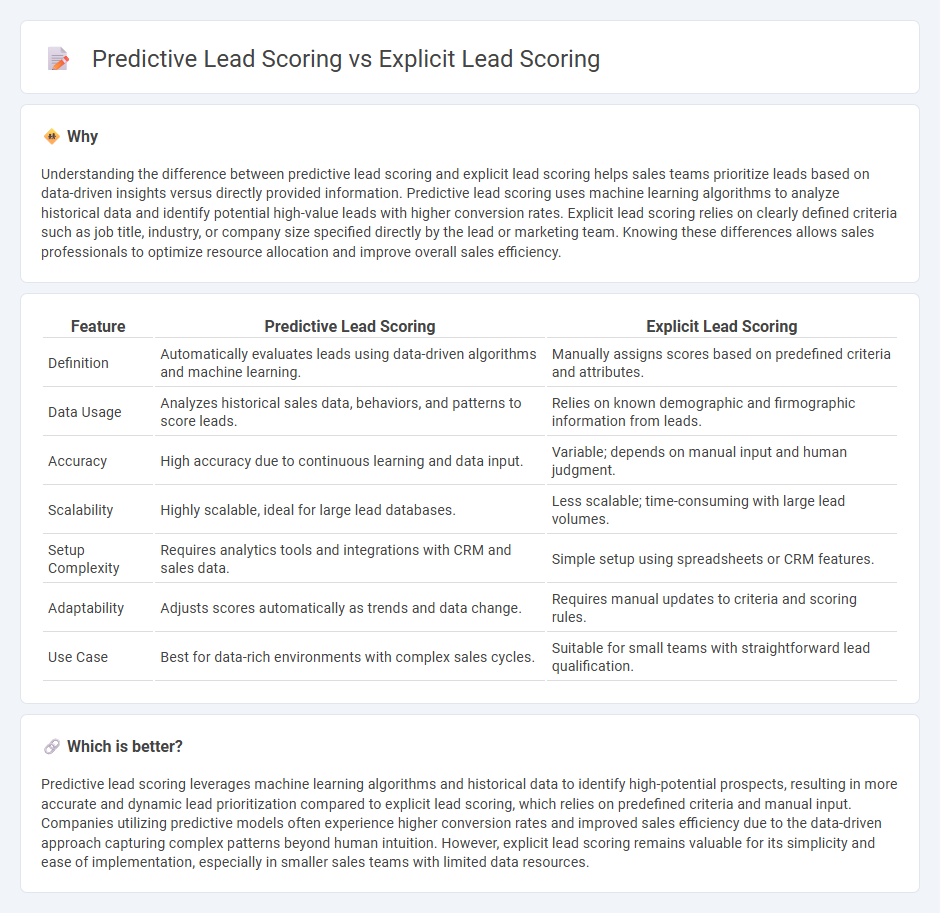
Predictive lead scoring uses machine learning algorithms to analyze historical data and customer behaviors, identifying high-potential leads with greater accuracy. Explicit lead scoring relies on self-reported information such as demographics or expressed interests, providing straightforward but sometimes limited insights. Explore how integrating both approaches can enhance your sales pipeline efficiency and boost conversion rates.
Why it is important
Understanding the difference between predictive lead scoring and explicit lead scoring helps sales teams prioritize leads based on data-driven insights versus directly provided information. Predictive lead scoring uses machine learning algorithms to analyze historical data and identify potential high-value leads with higher conversion rates. Explicit lead scoring relies on clearly defined criteria such as job title, industry, or company size specified directly by the lead or marketing team. Knowing these differences allows sales professionals to optimize resource allocation and improve overall sales efficiency.
Comparison Table
| Feature | Predictive Lead Scoring | Explicit Lead Scoring |
|---|---|---|
| Definition | Automatically evaluates leads using data-driven algorithms and machine learning. | Manually assigns scores based on predefined criteria and attributes. |
| Data Usage | Analyzes historical sales data, behaviors, and patterns to score leads. | Relies on known demographic and firmographic information from leads. |
| Accuracy | High accuracy due to continuous learning and data input. | Variable; depends on manual input and human judgment. |
| Scalability | Highly scalable, ideal for large lead databases. | Less scalable; time-consuming with large lead volumes. |
| Setup Complexity | Requires analytics tools and integrations with CRM and sales data. | Simple setup using spreadsheets or CRM features. |
| Adaptability | Adjusts scores automatically as trends and data change. | Requires manual updates to criteria and scoring rules. |
| Use Case | Best for data-rich environments with complex sales cycles. | Suitable for small teams with straightforward lead qualification. |
Which is better?
Predictive lead scoring leverages machine learning algorithms and historical data to identify high-potential prospects, resulting in more accurate and dynamic lead prioritization compared to explicit lead scoring, which relies on predefined criteria and manual input. Companies utilizing predictive models often experience higher conversion rates and improved sales efficiency due to the data-driven approach capturing complex patterns beyond human intuition. However, explicit lead scoring remains valuable for its simplicity and ease of implementation, especially in smaller sales teams with limited data resources.
Connection
Predictive lead scoring leverages machine learning algorithms to analyze historical data and forecast the likelihood of a lead converting, enhancing the accuracy of explicit lead scoring, which is based on predefined criteria and demographic information. The integration of predictive models refines explicit scoring parameters by identifying patterns and behaviors that indicate high-value prospects. This synergy enables sales teams to prioritize leads more effectively, accelerating conversion rates and optimizing resource allocation.
Key Terms
Criteria-based
Explicit lead scoring uses clearly defined criteria such as demographics, job title, and company size to assign scores to leads, making the evaluation process straightforward and transparent. Predictive lead scoring leverages machine learning algorithms and historical data to identify patterns and prioritize leads with the highest conversion potential, going beyond preset criteria. Discover how explicit and predictive lead scoring differ to optimize your lead management strategy effectively.
Machine learning
Explicit lead scoring relies on predefined criteria and manual data input to evaluate leads, focusing on attributes such as demographic information and firmographics. Predictive lead scoring leverages machine learning algorithms to analyze historical and real-time data, identifying patterns and behaviors that indicate the likelihood of conversion with higher accuracy. Explore how machine learning transforms lead scoring models to enhance sales efficiency and boost ROI.
Data-driven
Explicit lead scoring relies on quantifiable, user-provided data such as demographic and firmographic information to assign scores based on predefined criteria. Predictive lead scoring uses machine learning algorithms to analyze historical data patterns, behavioral signals, and engagement metrics to forecast lead conversion potential with higher accuracy. Explore the advantages of combining both models to enhance your data-driven sales strategy.
Source and External Links
What is lead scoring + the best lead scoring models - Zendesk - Explicit lead scoring assigns points based on objective qualities directly provided by the lead, such as job title, industry, company size, and geographic location, using clear-cut, demographic or firmographic data to evaluate leads.
Lead Scoring - Adobe Experience Cloud - Explicit lead scoring relies on information given directly by the prospect, including age, gender, geography, job title or company role, to help build a model focused on relevant, meaningful prospect engagement.
A Deep Dive into Lead Scoring Models - Outfunnel - Explicit scoring collects direct data from leads such as demographic and firmographic attributes--job title, seniority, company size, and industry--that come from forms or research, distinguishing it from implicit scoring based on behavioral data.
 dowidth.com
dowidth.com